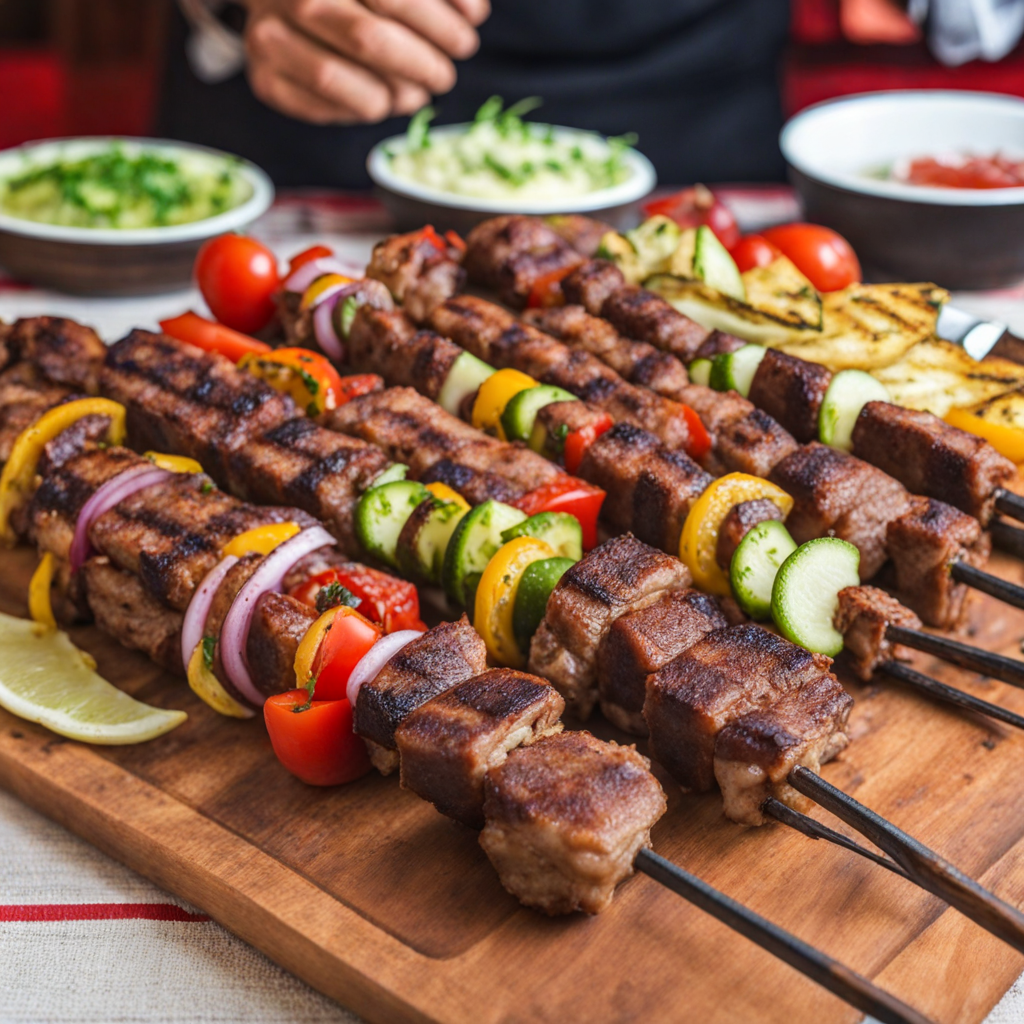Şiş Kebap
Şiş Kebap is a delightful Turkish dish that beautifully showcases the rich flavors of marinated meat, typically lamb, chicken, or beef, skewered and grilled to perfection. The meat is often infused with an array of spices, including cumin, paprika, and sometimes a hint of garlic, which not only enhances its taste but also gives it a vibrant aroma that is hard to resist. Traditionally, the meat is cut into bite-sized cubes, allowing it to absorb the marinade deeply, resulting in a tender and juicy texture after cooking. As the skewers are grilled over an open flame, the high heat caramelizes the outer layer, creating a tantalizing char that complements the succulent meat inside. The grilling process also adds a smoky flavor that elevates the dish, making it a favorite among BBQ enthusiasts. Şiş Kebap is often served with a side of fluffy rice or warm pita bread, along with fresh vegetables like tomatoes and bell peppers, which are sometimes grilled alongside the meat to enhance the overall presentation and flavor profile. To complete the dining experience, Şiş Kebap is frequently accompanied by a zesty yogurt sauce or a tangy salad, such as a traditional Turkish shepherd's salad, which adds a refreshing contrast to the richness of the kebab. Each bite offers a symphony of flavors, making it a must-try for anyone eager to explore the culinary delights of Turkish cuisine. Whether enjoyed at a bustling street market or a cozy restaurant, Şiş Kebap promises a memorable taste adventure that captures the essence of Turkey's vibrant food culture.
How It Became This Dish
The Engaging History of Şiş Kebap #### Origins Şiş Kebap, a cherished dish in Turkish cuisine, is a delightful skewered meat preparation that has its roots deeply embedded in the ancient traditions of the Middle East. The term "şiş" means "skewer" in Turkish, while "kebap" refers to grilled or roasted meat, often marinated to enhance flavor. Its origin can be traced back to the nomadic tribes of Central Asia, who would cook meat over open flames, skewering it on sticks as they traveled. These early practices laid the foundation for what would eventually evolve into the diverse kebab culture we see today. The concept of cooking meat on skewers has parallels in various cultures across the world, with similar dishes found in Persian, Arab, and even Mediterranean cuisines. However, it was during the Ottoman Empire (1299-1922) that kebabs began to flourish and take on distinct regional characteristics. The Ottomans, known for their culinary sophistication, embraced a wide array of spices, herbs, and cooking techniques, leading to the refinement of dishes like şiş kebap. #### Cultural Significance In Turkey, şiş kebap is more than just a meal; it is a symbol of hospitality and community. Turkish culture places great importance on sharing food, and kebabs are often enjoyed in gatherings, whether family dinners or festive celebrations. The act of grilling meat evokes a sense of togetherness, as friends and family come together to prepare and enjoy the dish. The cultural significance of şiş kebap is also reflected in its association with street food. In bustling cities like Istanbul, the aroma of grilling meat wafts through the air, drawing locals and tourists alike to street vendors who serve freshly prepared kebabs. This accessibility has made şiş kebap not just a dish but an integral part of Turkish urban life, showcasing the country’s rich culinary heritage to a global audience. #### Development Over Time As Turkey transitioned from the Ottoman Empire to the Republic in 1923, the culinary landscape began to evolve, but traditional dishes like şiş kebap remained steadfast. The simplicity of skewered meat made it a versatile dish that could be adapted to various tastes and preferences. Traditionally, şiş kebap is made with lamb or beef, marinated in a mixture of olive oil, garlic, oregano, and sometimes yogurt, which tenderizes the meat and infuses it with flavor. Over time, chicken and even fish variations have emerged, catering to diverse palates. The preparation method of şiş kebap has also seen innovations. While the classic method involves grilling over charcoal, modern adaptations include cooking on electric grills or even pan-searing. However, many purists argue that the authentic flavor comes from the smoky char of charcoal grilling, which adds a depth of flavor that is hard to replicate. Regional variations of şiş kebap have developed, influenced by local ingredients and traditions. In southeastern Turkey, for example, you may find kebabs spiced with regional herbs like sumac and served with flatbreads and fresh vegetables. In contrast, in the western regions, it might be accompanied by a fresh tomato and cucumber salad, or even a rich yogurt sauce, showcasing the adaptability of the dish to local tastes. #### Şiş Kebap in Contemporary Turkey In contemporary Turkey, şiş kebap continues to be a staple in restaurants, homes, and street stalls. It is served in various settings, from casual eateries to upscale dining establishments, often accompanied by rice pilaf, grilled vegetables, and a tangy salad. The dish has also made its way into international culinary scenes, often appearing on menus of Middle Eastern and Mediterranean restaurants around the world. The popularity of şiş kebap has spurred the emergence of kebab festivals and competitions in Turkey, where chefs showcase their skills and creativity in preparing this beloved dish. These events celebrate not only the culinary artistry involved in making kebabs but also the cultural heritage linked to this food. #### Conclusion Şiş kebap embodies the rich tapestry of Turkish history and culture. From its humble beginnings in the nomadic traditions of Central Asia to its status as a national icon of Turkish cuisine, this skewered meat dish has evolved while remaining true to its roots. As a symbol of hospitality, community, and culinary tradition, şiş kebap continues to bring people together, bridging generational gaps and fostering a shared love for food. Its adaptability and enduring popularity ensure that şiş kebap will remain a cherished dish for years to come, inviting everyone to partake in the flavors and stories that it represents. Whether enjoyed at a bustling street stall in Istanbul or served at a family gathering, şiş kebap is more than just a meal; it is a celebration of Turkish culinary heritage and a testament to the enduring power of food to unite us all.
You may like
Discover local flavors from Turkey







